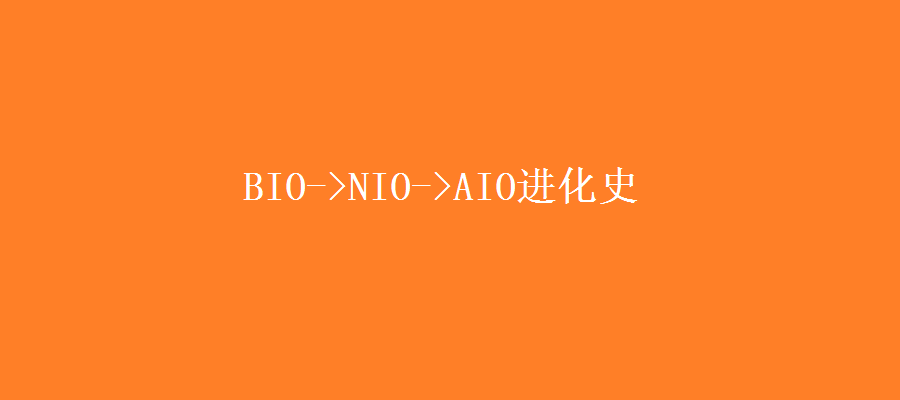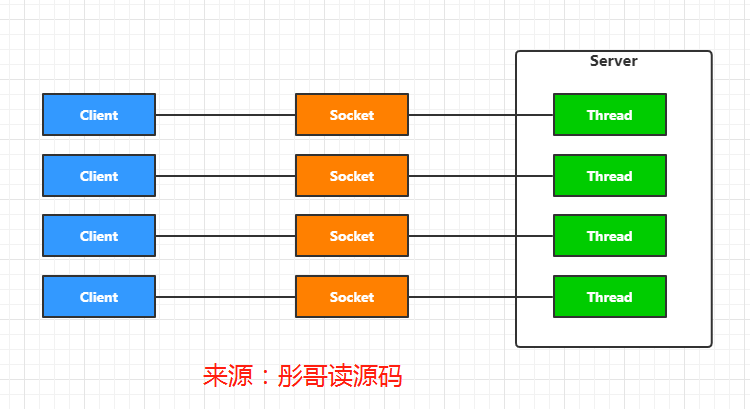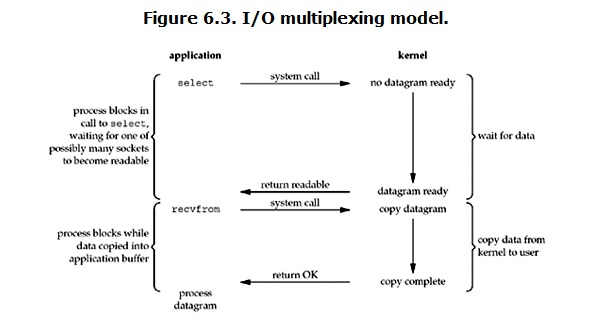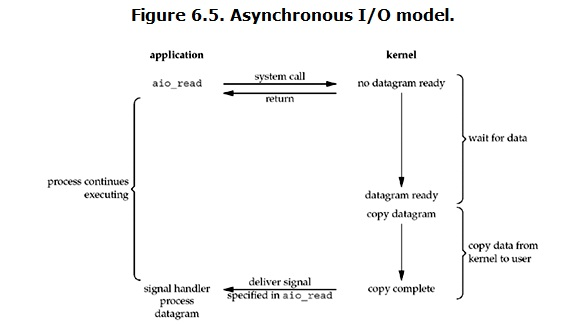
你好,我是彤哥,本篇是netty系列的第三篇。
简介
上一章我们介绍了IO的五种模型,实际上Java只支持其中的三种,即BIO/NIO/AIO。
本文将介绍Java中这三种IO的进化史,并从使用的角度剖析它们背后的故事。
Java BIO
BIO概念解析
BIO,Blocking IO,阻塞IO,它是Java的上古产品,自出生就有的东西(JDK 1.0)。
使用BIO则数据准备和数据从内核空间拷贝到用户空间两个阶段都是阻塞的。

BIO使用案例
public class EchoServer {
public static void main(String[] args) throws IOException {
ServerSocket serverSocket = new ServerSocket(8080);
while (true) {
System.out.println("start accept");
Socket socket = serverSocket.accept();
System.out.println("new conn: " + socket.getRemoteSocketAddress());
new Thread(()->{
try {
BufferedReader reader = new BufferedReader(new InputStreamReader(socket.getInputStream()));
String msg;
// 读取消息,本文来源公从号彤哥读源码
while ((msg = reader.readLine()) != null) {
if (msg.equalsIgnoreCase("quit")) {
reader.close();
socket.close();
break;
} else {
System.out.println("receive msg: " + msg);
}
}
} catch (IOException e) {
e.printStackTrace();
}
}).start();
}
}
}
客户端可以使用telnet来测试,而且你可以使用多个telnet来测试:
[c:~]$ telnet 127.0.0.1 8080
Connecting to 127.0.0.1:8080...
Connection established.
To escape to local shell, press 'Ctrl+Alt+]'.
hello world
我是人才
quit
Connection closed by foreign host.
BIO的使用方式非常简单,服务端接收到一个连接就启动一个线程来处理这个连接的所有请求。

所以,BIO最大的缺点就是浪费资源,只能处理少量的连接,线程数随着连接数线性增加,连接越多线程越多,直到抗不住。
Java NIO
NIO概念解析
NIO,New IO,JDK1.4开始支持,内部是基于多路复用的IO模型。

这里有个歧义,很多人认为Java的NIO是Non-Blocking IO的缩写,其实并不是。
使用NIO则多条连接的数据准备阶段会阻塞在select上,数据从内核空间拷贝到用户空间依然是阻塞的。
因为第一阶段并不是连接本身处于阻塞阶段,所以通常来说NIO也可以看作是同步非阻塞IO。
NIO使用案例
public class EchoServer {
public static void main(String[] args) throws IOException {
Selector selector = Selector.open();
ServerSocketChannel serverSocketChannel = ServerSocketChannel.open();
serverSocketChannel.bind(new InetSocketAddress(8080));
serverSocketChannel.configureBlocking(false);
// 将accept事件绑定到selector上
serverSocketChannel.register(selector, SelectionKey.OP_ACCEPT);
while (true) {
// 阻塞在select上
selector.select();
Set<SelectionKey> selectionKeys = selector.selectedKeys();
// 遍历selectKeys
Iterator<SelectionKey> iterator = selectionKeys.iterator();
while (iterator.hasNext()) {
SelectionKey selectionKey = iterator.next();
// 如果是accept事件
if (selectionKey.isAcceptable()) {
ServerSocketChannel ssc = (ServerSocketChannel) selectionKey.channel();
SocketChannel socketChannel = ssc.accept();
System.out.println("accept new conn: " + socketChannel.getRemoteAddress());
socketChannel.configureBlocking(false);
socketChannel.register(selector, SelectionKey.OP_READ);
} else if (selectionKey.isReadable()) {
// 如果是读取事件,本文来源公从号彤哥读源码
SocketChannel socketChannel = (SocketChannel) selectionKey.channel();
ByteBuffer buffer = ByteBuffer.allocate(1024);
// 将数据读入到buffer中
int length = socketChannel.read(buffer);
if (length > 0) {
buffer.flip();
byte[] bytes = new byte[buffer.remaining()];
// 将数据读入到byte数组中
buffer.get(bytes);
// 换行符会跟着消息一起传过来
String content = new String(bytes, "UTF-8").replace("
", "");
if (content.equalsIgnoreCase("quit")) {
selectionKey.cancel();
socketChannel.close();
} else {
System.out.println("receive msg: " + content);
}
}
}
iterator.remove();
}
}
}
}
这里同样使用telnet测试,而且你可以使用多个telnet来测试:
[c:~]$ telnet 127.0.0.1 8080
Connecting to 127.0.0.1:8080...
Connection established.
To escape to local shell, press 'Ctrl+Alt+]'.
hello world
我是人才
quit
Connection closed by foreign host.
NIO的使用方式就有点复杂了,但是一个线程就可以处理很多连接。
首先,需要注册一个ServerSocketChannel并把它注册到selector上并监听accept事件,然后accept到连接后会获取到SocketChannel,同样把SocketChannel也注册到selector上,但是监听的是read事件。

NIO最大的优点,就是一个线程就可以处理大量的连接,缺点是不适合处理阻塞性任务,因为阻塞性任务会把这个线程占有着,其它连接的请求将得不到及时处理。
Java AIO
AIO概念介绍
AIO,Asynchronous IO,异步IO,JDK1.7开始支持,算是一种比较完美的IO,Windows下比较成熟,但Linux下还不太成熟。

使用异步IO则会在请求时立即返回,并在数据已准备且已拷贝到用户空间后进行回调处理,两个阶段都不会阻塞。
AIO使用案例
public class EchoServer {
public static void main(String[] args) throws IOException {
AsynchronousServerSocketChannel serverSocketChannel = AsynchronousServerSocketChannel.open();
serverSocketChannel.bind(new InetSocketAddress(8080));
// 监听accept事件,本文来源公从号彤哥读源码
serverSocketChannel.accept(null, new CompletionHandler<AsynchronousSocketChannel, Object>() {
@Override
public void completed(AsynchronousSocketChannel socketChannel, Object attachment) {
try {
System.out.println("accept new conn: " + socketChannel.getRemoteAddress());
// 再次监听accept事件
serverSocketChannel.accept(null, this);
// 消息的处理
while (true) {
ByteBuffer buffer = ByteBuffer.allocate(1024);
// 将数据读入到buffer中
Future<Integer> future = socketChannel.read(buffer);
if (future.get() > 0) {
buffer.flip();
byte[] bytes = new byte[buffer.remaining()];
// 将数据读入到byte数组中
buffer.get(bytes);
String content = new String(bytes, "UTF-8");
// 换行符会当成另一条消息传过来
if (content.equals("
")) {
continue;
}
if (content.equalsIgnoreCase("quit")) {
socketChannel.close();
break;
} else {
System.out.println("receive msg: " + content);
}
}
}
} catch (Exception e) {
e.printStackTrace();
}
}
@Override
public void failed(Throwable exc, Object attachment) {
System.out.println("failed");
}
});
// 阻塞住主线程
System.in.read();
}
}
这里同样使用telnet测试,而且你可以使用多个telnet来测试:
[c:~]$ telnet 127.0.0.1 8080
Connecting to 127.0.0.1:8080...
Connection established.
To escape to local shell, press 'Ctrl+Alt+]'.
hello world
我是人才
quit
Connection closed by foreign host.
AIO的使用方式不算太复杂,默认会启一组线程来处理用户的请求,而且如果在处理阻塞性任务,还会自动增加新的线程来处理其它连接的任务。
首先,创建一个AsynchronousServerSocketChannel并调用其accept方法,这一步相当于监听了accept事件,在收到accept事件后会获取到AsynchronousSocketChannel,然后就可以在回调方法completed()里面读取数据了,当然也要继续监听accept事件。
AIO最大的优点,就是少量的线程就可以处理大量的连接,而且可以处理阻塞性任务,但不能大量阻塞,否则线程数量会膨胀。
槽点
(1)三种IO的实现方式中对于换行符的处理竟然都不一样,BIO中不会把换行符带过来(其实是带过来了,因为用了readLine()方法,所以换行符没了),NIO中会把换行符加在消息末尾,AIO中会把换行符当成一条新的消息传过来,很神奇,为啥不统一处理呢,也很疑惑。
(2)JDK自带的ByteBuffer是一个难用的东西。
总结
本文我们从概念和使用两个角度分别介绍了BIO/NIO/AIO三种IO模型。
问题
看起来JDK的实现似乎很完美啊,为什么还会有Netty呢?
最后,也欢迎来我的公从号彤哥读源码系统地学习源码&架构的知识。
